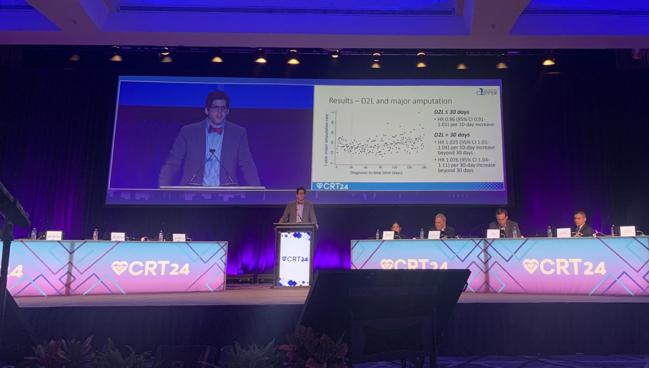CLIPPER: Emphasis on Faster Revascularization Could Change CLTI Care
Akin to the “time is myocardium” concept, a new study suggests that quick treatment could save legs, says Alexander Fanaroff.

WASHINGTON, DC—In patients with chronic limb-threatening ischemia (CLTI), delays longer than 30 days from the time of diagnosis to initiation of endovascular revascularization are associated with an increased risk of amputation, data from the CLIPPER cohort suggest.
Researchers say this situation could be mitigated by the use of a new time-centric metric.
The metric, known as diagnosis-to-limb revascularization time (D2L), takes its inspiration from the highly successful door-to-balloon (D2B) time performance measure used for more than a decade in STEMI, said Alexander C. Fanaroff, MD (University of Pennsylvania, Philadelphia), who presented the results here at CRT 2024.
“The door-to-balloon concept greatly improved the quality of STEMI care, and CLTI is overdue for that kind of quality routine,” he told TCTMD. “Certainly, there are limitations to what we've done, but it's proof of concept that in CLTI moving relatively quickly matters.”
Similar to the “time is myocardium” concept that has been demonstrated for patients with STEMI, and the role of prompt care in stroke, the CLIPPER cohort suggests that time is leg: patients in the study who underwent revascularization within 30 days of diagnosis were not at increased risk of lower limb amputation while those with delays had a 2.5% greater risk of major amputation for every 10-day delay beyond 30 days.
CLIPPER Findings
For the study, Fanaroff and colleagues analyzed Medicare fee-for-service claims data on 1,130,065 patients between 66 and 86 years old with a diagnosis of CLTI. Of these, 8.8% of patients (mean age 75 years; 44% female; 13% Black) underwent outpatient lower extremity revascularization within 180 days. Two groups were then compared, with 45.8% undergoing revascularization within 30 days of diagnosis and the remaining 54.2% being revascularized between 31 and 180 days after diagnosis.
Compared with patients revascularized within 30 days, those with delays were more likely to have Rutherford 5 or 6 classification, diabetes, chronic kidney disease, and chronic lung disease (P < 0.001 for all comparisons).
This is the first step in convincing societies and payers that this is an important problem that we should act on. Alexander C. Fanaroff
For patients revascularized within 30 days of a CLTI diagnosis, there was no association between D2L time and the 1-year major amputation rate. However, among the group with revascularization beyond 30 days, there were associations with greater amputation risk for every 10-day delay beyond 30 days (HR 1.025; 95% CI 1.01-1.04) and for every 30-day delay beyond 30 days (HR 1.076; 95% CI 1.04-1.11). Looking at both major and minor amputations, there was a 2% heightened risk for every 10-day increase beyond 30 days of diagnosis (HR 1.02; 95% CI 1.01-1.02).
No association was seen between D2L time and all-cause mortality in either group.
Collaboration of Care Needed
Fanaroff noted that care coordination in CLTI is made more complicated by the fact that patients are often older, members of historically marginalized racial and ethnic groups, and/or at low socioeconomic status, all of which contribute to difficulty navigating the healthcare system.
Within this complex web, “there are limited incentives and information for stakeholders to develop collaborative patient-centered care processes,” he said in his presentation.
Panelist Rachel Rosovsky, MD, PhD (Massachusetts General Hospital, Boston), suggested that given the greater comorbidities in the group with later revascularization, some physicians may have been more focused on those serious illnesses than on the CLTI and questioned what can be done to improve the situation.
Fanaroff agreed, but added that having more comorbidities on top of CLTI also can be a marker of decreased access to healthcare, which likely is another piece of the puzzle.
“I think that it would make sense to target those [sicker] patients for earlier revascularization, but in general it makes sense to target all of our patients with CLTI because that is what the data show, where possible,” he added.
To TCTMD, Fanaroff acknowledged that there is a vast amount of work needed to shape the D2L concept in a manner similar to the comprehensive initiative that resulted in the success of D2B in STEMI. Part of the underpinnings of D2B are evidence-based strategies that allow for a streamlined and consistent care pathway across institutions and demographics.
“In some ways [D2L] is less of a challenge than door-to-balloon because you're not dealing with minutes, you're dealing with days or weeks. On the other hand, care coordination in the outpatient setting is just incredibly challenging,” Fanaroff noted. “There are a lot of people who will need to buy in, because people are diagnosed with CLTI in vascular labs and in primary care doctors’ offices, and by podiatrists. It's a much broader set of people than are diagnosing STEMI.”
Ultimately, he said while concrete efforts by professional societies to improve care for CLTI patients are needed along with more evidence, “this is the first step in convincing societies and payers that this is an important problem that we should act on.”
L.A. McKeown is a Senior Medical Journalist for TCTMD, the Section Editor of CV Team Forum, and Senior Medical…
Read Full BioSources
Fanaroff A. The association between diagnosis-to-limb revascularization time and clinical outcomes in outpatients with chronic limb-threatening ischemia. Presented at: CRT 2024. March 12, 2024. Washington, DC.
Disclosures
- The analysis was funded by Boston Scientific.
- Fanaroff reports research support from Abbott Vascular and Prolocor; and consulting fees from Abbott Laboratories and Intercept.





Comments